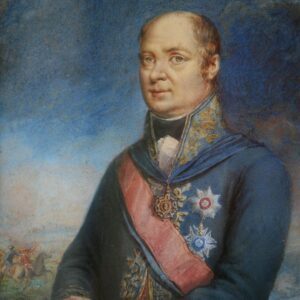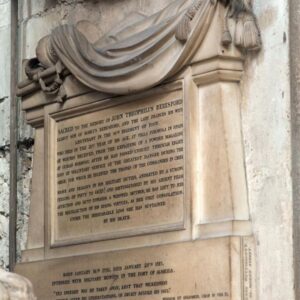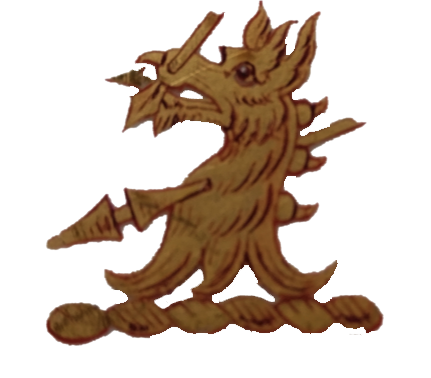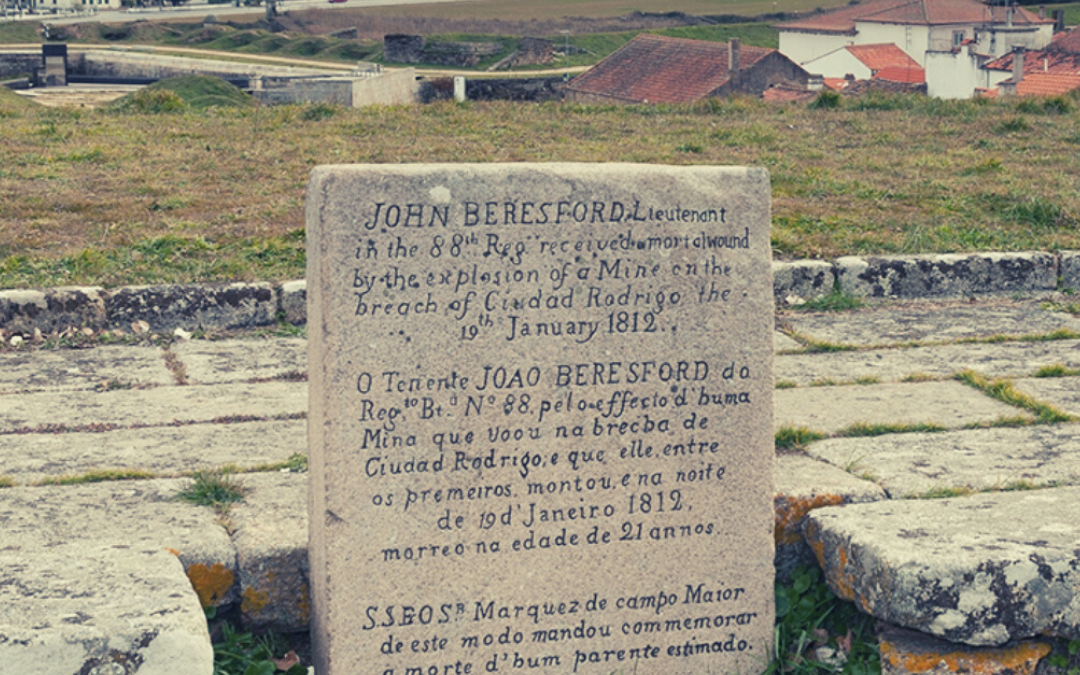On 29 January 1812 a young lieutenant in the 88th regiment of foot lost his fight for life having been wounded in the storming of Ciudad Rodrigo 10 days earlier. Lieutenant John Theophilus Beresford was the son of Marcus Beresford and Lady Frances Arabella Leeson, and a grandson of John Beresford, The Revenue Commissioner. His death might have gone unnoticed by all save family and close friends had his cousin not been Sir William Carr Beresford, Marshal of the Portuguese army and Colonel of the regiment. The short military career of John Theophilus is best placed in the context of the raising and deployment of the 88th regiment.
The background to the raising of the 88th regiment of infantry in the British army is well known. The regiment that came to be known as the Connaught Rangers or even ‘The Devil’s Own’ was raised in 1793 by John Thomas de Burgh, later Earl of Clanrickarde; one of a number of new regiments brought into existence to combat the threat posed by revolutionary France. Traditionally recruiting in Connacht, what is less well appreciated is how Waterford families became associated with the 88th in its early days.
One of a number of rising stars in the British service in the 1790s was William Carr Beresford. Later, Marshal Viscount Beresford, he saw service at the siege of Toulon in 1793 and in early 1794 gained his majority following the capture of Corsica. Carr, as he was referred to by the family at this time was the natural son of the first Marquis of Waterford, George de la Poer Beresford. In 1794 the Marquis of Waterford raised a regiment of foot, the 124th, to which William Carr Beresford was appointed Lieutenant-Colonel. It was however to be a short-lived appointment for the regiment was disbanded a year later with men and officers being incorporated into the 88th. With effect from 1 September 1795 Beresford was appointed Lieutenant – Colonel of the 88th and on 9 February 1807 Colonel of the regiment, a post he held until 1819.
William Carr Beresford served with the 88th for most of the next ten years following his appointment as lieutenant-colonel. Destined for the West Indies in 1795 as part of a force under Rear Admiral Christian, the regiment became widely dispersed when gales lashed the fleet.

William Carr Beresford
Reassembled the regiment was used to garrison Jersey in 1797-98 before being withdrawn and sent to India. It arrived in India in 1800 after the main action of the wars there had been completed and was soon dispatched as part of a force under Sir David Baird to counter the French threat in Egypt. William Carr Beresford, at this stage in command of a brigade which included the 88th, took part in what came to be viewed as an epic march from Kosseir on the Red Sea to Cairo in the summer of 1801. Following the surrender of the French in Egypt, the 88th garrisoned Alexandria where Beresford was Commandant, being the last British regiment to leave Egypt in 1803. The 88th was not with Beresford when he captured Buenos Aires in 1806, but did form part of the relieving force under General Whitelocke which surrendered in circumstances resulting in that General’s court martial in 1807. In 1809 the 88th joined Wellington’s army in Portugal and fought with distinction in the Peninsula until the end of the war in 1814. Amongst its battle honours in that war were Talavera, Bussaco, Fuentes de Onoro, Ciudad Rodrigo, Badajoz, Salamanca, Vitoria, Orthez and Toulouse. In 1809 also Beresford (by then a Major General in the British army) was appointed Marshal of the Portuguese army, reforming and rebuilding it over the next couple of years, with the result that Wellington and other British generals viewed its fighting capabilities as comparable to its British counterpart. By the end of the war Wellington had as many Portuguese as British in the allied army.
John Theophilus Beresford was born on 16 January 1792, a year after his parents marriage. His father, Marcus (1764-1797) was a barrister and MP for Dungarvan from 1783 until his own early death in 1797. Not a lot is known about Marcus, save that he was a friend of Wolfe Tone and took steps to help him when he first came to the attention of the government for his republican activities. Apart from John Theophilus, Marcus and Frances Arabella had another son, William who was to become a successful politician and a daughter, Elisabeth.
At 16 years of age John Theophilus joined the army becoming a second lieutenant in the 23rd regiment of foot, another regiment that was to win renown and suffer horrific losses in the Peninsula. That regiment took part in the retreat to La Coruna under Sir John Moore but it seems clear from the date of his commission that John Theophilus arrived in the Peninsula some time later. He did not stay long with the 23rd regiment for he was posted as a lieutenant to the 88th with seniority dated from 28 June 1810. It is not even clear whether at that time he was in Portugal. What is clear is that in the autumn of 1810 John Theophilus was in England for he is documented as traveling from England to Portugal towards the end of that year to join the 88th ; Colonel Thomas McMahon on that occasion describing him as a ‘fine young man.’ In the spring of the following year the 88th played a major part in the battle of Fuentes de Onoro and John Theophilus may well have been with the regiment there, though no reference to this effect has been found.
The 88th regiment formed part of the 3rd Division led by Lieutenant-General Thomas Picton who allegedly referred to them as ‘the Connaught Footpads’ on first inspecting them under Lieutenant – Colonel Wallace in the neighbourhood of Trancoso in northern Portugal in 1810, though he was later to admit to Wallace that ‘he had every occasion to be satisfied with the general conduct of the corps since my joining the division.’ That initial encounter certainly seems to have affected the attitude of the men of the 88th towards Picton thereafter and there are a number of reports of the General being received coolly subsequently by the troops of the regiment. While the 88th certainly had an interesting disciplinary record at this time, the reality was that not only Picton but more importantly Wellington valued the regiment greatly. Wellington mentioned the regiment and/or individuals serving with it in many of his despatches reporting battles, including Busaco, Fuentes de Onoro and Salamanca .
1811 was in many ways the turning point of the war in the Peninsula. Massena’s ‘Army of Portugal’ retired from the Lines of Torres Vedras having suffered extraordinary losses in terms of human life, many from starvation rather than fighting. This retreat was followed by Allied successes at Fuentes de Onoro and Albuera. Though both battles proved to be sanguinary affairs, the outcome was that apart from a diversionary advance in 1812 by Massena’s successor, General Marmont, no further attempt was made by the French to invade Portugal. Wellington realised however that no substantial advance into Spain could be made before reducing the great Spanish border fortresses of Ciudad Rodrigo and Badajoz then in French hands. Attempts to capture Badajoz had failed in 1811 and similarly the allied army had failed to prevent the French resupplying Ciudad Rodrigo in the autumn of that year. Wellington now resolved on the bold stroke of a winter siege of Ciudad Rodrigo in early 1812 and to that end invested the city while the French army was dispersed in winter quarters in early January. His task was made somewhat easier by Napoleon’s withdrawal of troops from the Peninsula for his Russian campaign and by his direction to Marmont, to send support to General Suchet in eastern Spain.
In the autumn and early winter of 1811 Wellington moved his siege train to Almeida, the Portuguese border fortress opposite Ciudad Rodrigo. The siege began on 8 January 1812 and progress was so swift that practicable breaches enabled the city to be stormed just after 7 p.m. on 19 January, long before the French were able to react by putting together a relieving force. The assault was made by the 3rd and Light Divisions commanded by Generals Picton and Craufurd respectively, while a ‘false attack was led by General Pack and his Portuguese brigade was made on the south wall.
The particular brigade of the 3rd Division with the 88th including John Theophilus was led by General Henry MacKinnon. It attacked the principal breach and broke through the French defences. Initially, John Theophilus was in command of the sap being performed by the 88th. He had volunteered for this task. The job of the sappers was to throw bags filled with straw into the ditch adjacent to the breach so that the following troops, the Forlorn Hope, could have a ‘safe’ descent. As such the sappers were exposed to a withering fire from the defenders. When the allied troops were near the top of the breach, Mackinnon directed part of the 88th to clear the ramparts to his right but told John Theophilus to remain with him as he worked his way left, reportedly saying ‘Come Beresford, you are a fine lad, we will go together.’ Just after this exchange, the French detonated a mine within the bastion which ‘ shook the bastion to its foundation.’ William Grattan describes the event ‘ Mackinnon, at the head of his brigade, was blown into the air. His aide de camp, Lieutenant Beresford of the 88th shared the same fate, and every man on the breach perished.’
In fact while General Mackinnon perished there and then, the injuries to John Theophilus were not thought at first to be life threatening, though he clearly had serious burns. He was treated on site initially before being removed to the Marshal’s quarters in Villa Formosa. Writing to his brother John Poo Beresford, the day after the successful assault on Ciudad Rodrigo, the Marshal referred to the fact that Mackinnon had raised John Theophilus to aide de camp. Describing the explosion he went on to say ‘John has become very much burnt in the face, and all his hair, he will be in great pain for some time and though this wound may be called severe yet there is nothing in the least dangerous in it. He goes tomorrow to my house in Villa Formosa. He volunteered the service he was on which was a very perilous one.’
The journey from Ciudad Rodrigo to the Marshal’s house in Villa Formoso must have been painful in John Theophilus’s condition. The weather was harsh and assuming he was brought on a cart over a distance of some 30 kilometres the trip must have taken many hours. While the Marshal soon realised the serious extent of his nephew’s injuries, a week later on 28 January he wrote with guarded optimism to his sister Lady Anne Beresford :
‘Poor John Beresford is in the next room to me and in just such a one as my own, only it does not leak from above he is as far as accommodation goes comfortable enough, but poor fellow he has had a most dreadful wound, much worse than I had imagined it, he has been delirious until yesterday, however he is now quite calm & all fever has left him, but the burns are dreadful, and he will be long before he recovers. I trust however he is out of danger & which the doctors think, though from such a wound it is difficult for a long time to be certain. He has taken a good deal of nourishment today & as he can now want for nothing & there is a medical gentleman only to take care of him, I have every hope that all will go well, but I am very anxious about him.’
Sadly, despite the Marshal’s efforts and the provision of dedicated medical care, John Theophilus died the following day, 29 January. When the news reached home in Ireland it must have been particularly harrowing for his mother and family for the early indications had been as has been noted that he was likely to survive. On 10 February 1812, some two weeks after his death, The Waterford Mirror mentioned that John Theophilus had been slightly wounded and even on 29 February 1812 the same paper only reported that he had been ‘severely wounded’ at Ciudad Rodrigo. It is not clear therefore when news of his demise reached the family in Ireland.
In life he had been honoured by Wellington who named the four members of the sap at Ciudad Rodrigo including John Theophilus and noted ‘they distinguished themselves not less in the storm of the place than they had in the performance of their laborious duty during the siege.’ In death he was honoured by Marshal Beresford who had him buried on the ramparts of the fortress of Almeida where his tombstone inscribed in Portuguese and English may be seen to this very day. In English it reads as follows: ‘ John Beresford Lieutenant in the 88th regt received a mortal wound by the explosion of a Mine on the breach of Ciudad Rodrigo the 19th January 1812.’
Interestingly the Portuguese attribution gives us rather more information. If we did not know it, we learn that John was one of the first into the breach on the night in question and that he died before his 21st birthday. Further we are told specifically that this headstone was erected by His Excellency the Marquis of Campo Maior to commemorate the death of a respected relative. That was a title granted by the Portuguese crown to Marshal Beresford.
Burial on the walls of any fortress was a signal honour usually reserved for senior officers. General Robert Craufurd who also died in the assault on Ciudad Rodrigo is buried there in the wall and General Mackinnon was buried initially in the breach though subsequently he was reinterred in Espija where his regiment, the 74th was based. It seems likely that Marshal Beresford’s influence secured this burial site. At the time protestants were excluded from burial in Portuguese catholic graveyards, and it is interesting to note that following the battle of Albuera in 1811, the Marshal had secured permission to bury a number of officers who fell there and at Badajoz in a beautiful little cemetery on the walls of the massive fortress of Elvas, a cemetery still maintained today and certainly one of the oldest British army cemeteries on mainland Europe.
It would seem the Marshal’s influence extended further, for in Westminster Abbey there are plaques to three of those who fell at Ciudad Rodrigo; Generals Craufurd and Mackinnon and Lieutenant Beresford of the 88th. That dedicated to John Theophilus reads:
SACRED to the memory of JOHN THEOPHILUS BERESFORD, eldest son of Marcus Beresford and the Lady Frances his wife Lieutenant in the 88th Regiment of Foot, who died in the 21st year of his age, at Villa Formosa in Spain, of wounds received from the exploding of a powder magazine at Ciudad Rodrigo; after he had passed unhurt through eight days of voluntary service of the greatest danger during the siege; for which he received the thanks of the Commander in Chief. Brave and zealous in his military duties, animated by a strong feeling of piety to GOD! and distinguished by his ardent filial affection and duty towards his widowed mother; he has left to her the recollection of his rising virtues, as her only consolation, under the irreparable loss she has sustained by his death. Born January 16th1792, died January 29th 1812, Interred with military honours in the fort of Almeida. “Yea speedily was he taken away, lest that wickedness should alter his understanding, or deceit beguile his soul.”


